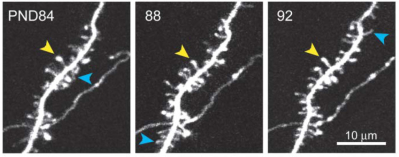Transient and Persistent Dendritic Spines in the Neocortex In Vivo
Dendritic spines were imaged over days to months in the apical tufts of neocortical pyramidal neurons (layers 5 and 2/3) in vivo. A fraction of thin spines appeared and disappeared over a few days, while most thick spines persisted for months. In the somatosensory cortex, from postnatal day (PND) 16 to PND 25 spine retractions exceeded additions, resulting in a net loss of spines. The fraction of persistent spines (lifetime ≥ 8 days) grew gradually during development and into adulthood (PND 16–25, 35%; PND 35–80, 54%; PND 80–120, 66%; PND 175–225, 73%), providing evidence that synaptic circuits continue to stabilize even in the adult brain, long after the closure of known critical periods. In 6-month-old mice, spines turn over more slowly in visual compared to somatosensory cortex, possibly reflecting differences in the capacity for experience-dependent plasticity in these brain regions.
Holtmaat A, Trachtenberg, JT, Wilbrecht L, Shepherd GM, Zhang XQ, Knott GW, Svoboda K. 2005. Transient and Persistent Dendritic Spines in the Neocortex In Vivo. Neuron. 45(2):279-91 (Full Text)
